ATRO with Additional Link Modules

The modular industrial robot system ATRO (Automation Technology for Robotics) from Beckhoff was first presented to the public in 2022. Fast-forward to today, and more link modules are now being added to increase the flexibility of the ATRO system even further, including in the form of multi-arm robots.
The standardized ATRO motor modules with integrated drive functionality are combined with link modules in different geometries, offering users the flexibility to set up a variety of robot kinematics. This results in robotics solutions that are precisely optimized to suit the application in question. The complete integration of the robot controller into the TwinCAT control platform with its extensive automation functionalities also facilitates the whole process of implementing complete solutions for a machine.
As mechanically passive modules, ATRO link modules are used to adapt the kinematic structure or the workspace to the respective requirements. The latest additions to be showcased include a T-shaped link module with two junctions, in addition to both L- and S-shaped models. Automatica 2023 provided the perfect opportunity to present a sample application featuring 2-arm robot kinematics based on the T-module, each with four motor modules (i.e., joints) in the arms. The common main axis could be used as a continuously rotating axis and thus as a moving robot base, since all axes in the ATRO system from the base to the end effector are designed to rotate endlessly due to the internal media feed. The two arms are thus simultaneously guided to different work areas where they can grip, set down, or machine workpieces. The entire structure not only saves space but also offers a fast and efficient solution. This is because it eliminates the need for the robot to perform any of the typical return travel associated with axis limitations, in which no process execution takes place. The compressed air or energy supply to the two grippers is routed internally in the structure from the basic main axis to the two end effectors through the ATRO interfaces of the modules. The new L- and S-shaped link modules support kinematics with four degrees of freedom, which can be used for tasks such as palletizing. A special feature of one of the new L-shaped link modules was demonstrated at another exhibition: the axes of this robot configuration are designed in such a way that they cannot collide with themselves, which means that the endless rotation of all axes can be exploited to optimal effect. In all (other) robot configurations, self-collision is avoided by software.
Another innovation in the entire Beckhoff system is the implementation of the pluggable and modular MX-System as a robot and machine controller. An MX-System configuration consisting of a power supply, industrial PC, digital input/output, and safety modules allows the ATRO system to be operated completely control cabinet-free. The robot receives its required 48 V power supply and EtherCAT communication via a single hybrid cable from the new MX-System power supply module with a 40 A output current. For pneumatic control of the end effectors, the new pneumatic modules are available in the MX-System. The result is a complete, compact, control cabinet-free robot control system that can easily be expanded for further automation tasks within a machine or cell.
Image Source: Beckhoff Automation



 Facebook
Facebook.png) Twitter
Twitter Linkedin
Linkedin Subscribe
Subscribe